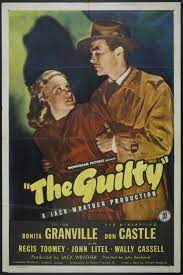
THE GUILTY
US, 1947, 73 minutes, Black-and-white.
Bonita Granville, Don Castle, Regis to me, Wally Cassell, John Litel.
Directed by John Reinhardt.
This brief supporting feature of 1947 has been restored and available on YouTube.
By the mid 1940s, thrillers, filmed in black and white, emphasis on light and, especially, shadow, crime stories were becoming more prevalent and more popular. And this continued particularly after the end of World War II, a number of the characters affected (examples of post traumatic stress disorder), uncertain of their mental state, in situations where they may have committed crimes.
This is the case with this short and effective film. Most of the action takes place at night, in apartments, in the streets, in a bar. During the opening credits, the camera follows the back of a man in coat and hat walking the streets of the city, eventually going into the bar, offering a narration for the whole film. It is six months since the episodes the audience sees in the flashbacks.
His name is Mike Carr, he is played quite effectively by Don Castle, an actor of many films but who never made it to the top, despite his screen presence and appearance. The narrative involves his sharing a room with a war buddy who is suffering from mental issues. There is a femme fatale, twins, played by Bonita Granville (who, that year, married in real life the producer of the film, Jack Wrather, and despite being a successful child star, moved out of filmmaking into production). She portrays a nice twin and an aggressive twin trying to act like Barbara Stanwyck. Twins live at home with their anxious mother and a friend of the family who has lived there for decades (John Litel).
There are various emotional tangles between the two men and the two girls, rendezvous, visits to the bar, various lies, a glimpse of the nice twin seemingly assaulted, lying on a bed. The narration continues with Mike helping his friend, investigating the case, the police called in, represented by Regis Toomey, Mike helping his friend to escape and hide, and a buildup to everybody meeting in the apartment.
There are several twists in the film, the seeming murderer and his being arrested, yet doubts, the femme fatale sister seemingly implicated as a possible suspect. For those who have read Agatha Christie’s The Murder of Roger Ackroyd, please stop reading now. Spoiler alert, the screenplay is from a story by Cornell Woolrich, crime writer particularly popular at this period, The Leopard Man, Night has 1000 Eyes, Rear Window, who seems to have been influenced by Agatha Christie’s Roger Ackroyd novel. An ending with a twist.